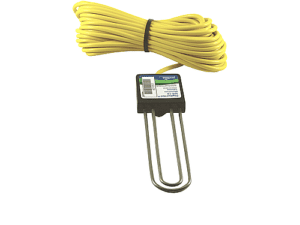Permittivity is a property of matter and is well characterized especially for materials that are electrically non-conductive. Water in its pure form is non-conductive. Permittivity quantifies the charge holding capacity for insulating materials. It is the ratio of stored electric charge to an applied electric field (Gauss’ Law). If two conductive plates are separated by air and are connected to a battery, electrons will accumulate on the positive plate, leaving the negative plate and create an electric field between the plates. This forms a storage mechanism for the electrons. The amount of charge per unit voltage applied is governed by the permittivity of the medium between the plates. If the plates are immersed in water the number of stored electrons will increase 80 times (water has a relative permittivity of 80 near room temperature). Thus by monitoring the current flow into and out of the plates resulting from an applied voltage change, it is possible to know the relative bulk permittivity of the medium between the plates, and since water is typically the only material in soil that has a high permittivity we can estimate how much water is in the soil. Probes designed around this concept are frequently referred to as capacitive probes but a more precise definition would be Gaussian probes since they are based in Gauss’ Law. Some permittivity probes do not appear to be capacitive probes by their architecture yet are nevertheless based in Gauss’ Law.
Beginning in 2001, Acclima developed and patented a means of transmitting and receiving fast-rising step functions and measuring their propagation time through soil with trillionths of a second resolution and accuracy.
Even though Gaussian sensors are more credible than their predecessors they suffer from a serious flaw, that being that they cannot overcome errors introduced with soil electrical conductivity (EC). If we are monitoring soil moisture in soils that do not conduct electricity, then Gaussian Probes will work well.
But when the soil receives a little fertilizer or slightly saline irrigation water the electron flow described by Ohm’s Law interferes with the ability to measure the ‘capacitive’ current and soil electric field, regardless of the particular circuit approach used in the sensor design. When the soil is conductive, electric currents flow through the soil in the presence of the applied electric fields. This occurs on a transient basis even when the plates are insulated from the soil. The currents create reverse fields in the soil (opposite to the applied field) that attenuate the local field in the soil. An increase in transient current flow also occurs. The ratio of the electric field to charge then increases causing a serious overestimation of permittivity and water content. Some Gaussian sensor manufacturers have attempted to compensate their probes for electrical conductivity, but soil electrical conductivity is very strongly dependent on water content. The two variables are not orthogonal and attempting to compensate water content with water-content-dependent conductivity measurements is futile.
Because of the prevalence of Gaussian sensors in the marketplace it is very important to include measurement stability vs. soil electrical conductivity in the evaluation of a soil moisture sensor. The EC stability of a sensor is one of the most important parameters – much more important than absolute accuracy. The accuracy of a sensor can be calibrated in the field but its susceptibility to erroneous readings due to changing conductivity cannot be compensated for. Increases in conductivity will be reported as increases in water content and the user has no reference for understanding what the actual water content is. If the user is controlling irrigation based on unstable readings he can easily lose his crop.
Fortunately there is another basic law of physics that can be used to measure permittivity that is immune to electrical conductivity. This is the Ampere/Faraday Law (actually two laws) that describes electromagnetic wave propagation. The speed at which light travels is governed by two properties of matter: electrical permittivity and magnetic permeability. Nearly all soils are non-magnetic and so the speed of light in soil is governed only by permittivity. Electrical conductivity has no effect on the speed of light but it does attenuate the wave. If we can measure the speed of light in the soil we can find the permittivity without interference from soil conductivity but we must be able to make accurate time measurements on events that occur in billionths of a second with accuracy and resolutions in the trillionths of a second. We must also be able to detect the timing of the first arrival of energy even though the wave may have diminished severely due to soil conductivity. A popular instrument that does this is called the Time Domain Reflectometer (TDR). The TDR contains a step function generator that launches an instantaneous voltage on a transmission line. The voltage propagates down the transmission line (similar to the ripple that propagates down a rope tied to a tree) and when the wave comes to the end of the transmission line it reflects back to the origin. If we accurately measure the time taken for the return of the voltage step we can determine quite precisely what the permittivity of the medium is, independent of all other parameters. Again, from permittivity we can estimate water content.

TDR instruments have been used since the 1980s for measuring soil water content. Clark Topp and others developed the procedure and experimentally derived a basic relationship between permittivity and water content called the Topp equation. TDR instruments had also been used for finding breaks and shorts in underground cables but applying them to measuring soil water content was a major breakthrough to accurate and stable soil water content measurement – unfortunately it was an expensive breakthrough. Today the TDR is used along with the neutron probe as reference instruments for establishing accurate soil water content readings. Neither instrument is suited for long-term deployment in the field due to cost, instrument size, and power considerations.

Beginning in 2001, Acclima developed and patented a means of transmitting and receiving fast-rising step functions and measuring their propagation time through soil with trillionths of a second resolution and accuracy. This facilitated the development of a TDR soil moisture sensor where the waveform generator, the digitizing receiver, and the precision timing circuitry were small enough to be incorporated directly into the probe in a small, low cost package. The first embodiment of the technology was a Time Domain Transmissometer (TDT) wherein the step function voltage is applied to one end of a transmission line that curves around and back to the housing where it is received. By bending the waveguide back to the circuit board we avoid the need to separate a reflected wave from the incident wave as is required in a TDR. We also avoid the attenuation of the waveform that occurs when it is reflected at the end of the waveguide. The TDT technology is more easily implemented than TDR technology and the TDT device can operate in more conductive soils than a TDR device can. The advantage of a TDR sensor is that it has straight, sharpened rods that can be pushed into a soil profile whereas the TDT requires excavation and repacking of the soil around the sensor’s looped rods. Otherwise these time domain methods are equivalent and both offer immunity to errors caused by soil conductivity and are independent of amplitude, current, impedance, or other Gaussian-related methods used to derive water content. Time domain sensors are also immune to errors that can be evident in other sensors when compacting the soil (soil electrical conductivity is affected by compaction – soil volumetric water content is also affected by compaction as it can push water from the spaces between soil particles but typically this is of lesser effect).
With Acclima’s introduction of TDT technology the cost of TDR-type technology was reduced from tens of thousands of dollars to hundreds of dollars. This makes it practical to install the sensor permanently thus offering stable soil moisture readings with TDR credibility at a small fraction of conventional TDR costs.

The importance of carefully analyzing a time domain waveform cannot be overemphasized. Soil conductivity and problems with the frequency response of clay soils will distort the waveform rising edge by elongating it and also by diminishing its amplitude. It is necessary to explore the weaker first appearance of energy in order to get an accurate propagation time measurement (without finding this the sensors would be sensitive to soil EC).



Acclima has developed special algorithms for this purpose and the Acclima sensors use patented waveform digitizing technology. The result is that the Acclima sensors are able to provide stable permittivity measurements with an accuracy of ±1% of full scale (relative permittivity from 1 to 80) even over the range of 0 to 4000 µS/cm bulk (in-soil) electrical conductivity.
